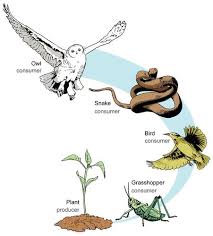What is one thing that is crucial for all organisms? Energy. All forms of life have energy, especially in forms of heat. The major source of energy is the Sun. Producers directly gain energy through sunlight, whereas consumers gain energy indirectly. Sunlight is also used when a loss of energy must be regained. Yet, energy gained in one trophic level does not stay only within that level. Rather, energy flows within food chains and ecosystems. Today we will learn about energy flow and the energy pyramid.
The Role of Sunlight
As mentioned before, sunlight is the initial source of energy. There are a few exceptions; in some ecosystems, producers derive their energy from chemical processes. When photoautotrophs absorb light energy, they convert it into chemical energy through photosynthesis. Autotrophs use this energy to synthesize organic compounds from inorganic sources, whereas heterotrophs use it to derive ATP, or chemical energy. Only after organic compounds are broken down after photosynthesis or consumption is an organism able to proceed metabolic processes such as cell division or ion exchange across membranes.
Here is a more technical explanation of high light energy is converted into chemical energy in the form of carbon compounds. Producers like plans, bacteria, and algae can make pigments such as chlorophyll to capture light during light-dependent reactions of photosynthesis. Light breaks water into protons and electrons, which transform carbon dioxide and water into glucose and carbon-based compounds through the Calvin cycle and ATP synthase.
Food Chains and Food Webs
A food chain is a model that represents how energy and nutrients are passed from producer to primary consumer, then secondary consumer, and so forth. It begins with plants and ends with animals. It shows the food source of each organism in the chain and the direction of energy flow. Typically, energy flows from producer to primary consumer to secondary consumer and then to tertiary consumer. Flow of energy is expressed as an arrow. Each of these steps is a trophic level.

Food webs are often confused with food chains. These two concepts, though they sound similar, are different. Food webs are models of ecosystems that show the interconnections among food chains. Most organisms have more than one food source and more than one predator, and often this complex relationships between organisms are much better represented by a food web. One similarity of food webs with food chains would be that arrows point in the direction of energy flow.

Energy Flow
Energy flow in a community is typically represented by an energy pyramid. Each block in a pyramid indicates groups of organisms that may constitute a food chain. In an energy pyramid, each successive trophic level is smaller in size. This is because energy is lost as heat from respiration, incomplete digestion and egestion of waste products. Thus an energy level only has 10%-20% of the energy from the previous level. As the amount of energy decreases as we go up the energy pyramid, the number of individual also decreases. This is because less energy can only support fewer individuals. There is actually a pyramid that expresses the number of individuals in each trophic level, and it is called a numbers pyramid.
Another type of an energy pyramid is a biomass pyramid. Biomass refers to the dried mass of organic material that fuels an ecosystem. A biomass pyramid quantifies and presents data of ecosystems so that the productivity and health can be analyzed. As we go up the pyramid, a trophic level becomes smaller since there are more producers than consumers. The biomass decreases as we move along a food chain since there is a loss of carbon dioxide, area, water, and other waste products. However, it is important to note that there are exceptions to the typical shape of energy pyramids depending on the ecosystem. For stance, in a temperate forest especially during the summer, the number of individuals in the base level is smaller than the number of individuals in upper levels.
Works Cited
Allott, Andrew. Biology: Course Companion. Oxford University Press, 2014.
Foundation, CK-12. “12 Foundation.” CK, http://www.ck12.org/book/CK-12-Life-Science-Concepts-For-Middle-School/section/12.18/.
Person, and wikiHow. “How to Draw a Food Web.” WikiHow, WikiHow, 31 July 2019, http://www.wikihow.com/Draw-a-Food-Web.
Leave a comment